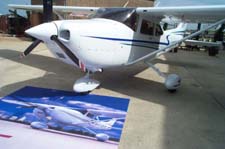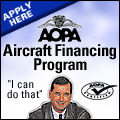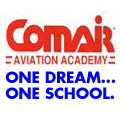Departments

Inside AOPA 
On Capitol Hill 
Airport Support Network

Quiz Me! 
The Road to Expo 
ePilot Calendar 
Weekend Weather
| GA News
| TWO-PLACE TRAINER TO COST LESS THAN $100,000
A two-place tricycle-gear trainer and recreational aircraft based on the successful Europa will enter the United States market in 2002. Pricing for the first 50 factory-built Liberty XL-2 aircraft is $85,000. After that, the Rotax 912S-powered aircraft will cost $92,000. Company officials said they are open to other engine options, but have no plans at present. The specifications call for a 600-lb useful load and a cruise speed of 120 knots. The aircraft was designed by Liberty Aerospace and will be built by Scaled Technology Works in Montrose, Colorado, the firm that is slated to build the Visionaire Vantage personal business jet. The firm also builds parts for the interiors of Cessna aircraft. An aircraft mockup will be displayed later this month at AOPA Expo in Long Beach, California. The first prototype is under construction. The Europa was originally a kitbuilt aircraft; more than 750 Europa planes have been sold in 32 countries. Certification by the FAA is expected in late 2001. The company says its marketing plan predicts sales of 400 Liberty XL-2 aircraft a year. For more information, visit the Web.
CESSNA 182 GOES TURBO
 Cessna Aircraft Company announced Monday at the NBAA convention in New Orleans enhancements to the venerable 182 Skylane. The new T182 and the T182TC offer a more refined interior, speed enhancements, and the addition of a Honeywell Bendix/King moving map display. With the speed enhancements, the normally aspirated 182 is expected to cruise at about 150 knots while the turbo will add 20 knots. A standard T182 will sell for around $242,000 while the turbo model will run $281,600. Cessna has been producing some 250 182s per year for the past couple of years and company officials expect that the improvements will boost the rate by 10 to 15 percent. Deliveries begin in January. Meanwhile, new 172s are coming off of the Independence, Kansas, production line at the rate of one every 3.5 working hours. Cessna has also launched an enhanced Web site featuring virtual reality tours of the Citation X and the Cessna 206, interactive brochures, image downloads and screensavers, links to product support tools, and online job applications. Visit the site. Cessna Aircraft Company announced Monday at the NBAA convention in New Orleans enhancements to the venerable 182 Skylane. The new T182 and the T182TC offer a more refined interior, speed enhancements, and the addition of a Honeywell Bendix/King moving map display. With the speed enhancements, the normally aspirated 182 is expected to cruise at about 150 knots while the turbo will add 20 knots. A standard T182 will sell for around $242,000 while the turbo model will run $281,600. Cessna has been producing some 250 182s per year for the past couple of years and company officials expect that the improvements will boost the rate by 10 to 15 percent. Deliveries begin in January. Meanwhile, new 172s are coming off of the Independence, Kansas, production line at the rate of one every 3.5 working hours. Cessna has also launched an enhanced Web site featuring virtual reality tours of the Citation X and the Cessna 206, interactive brochures, image downloads and screensavers, links to product support tools, and online job applications. Visit the site. RAYTHEON ANNOUNCES NEW HAWKER
Raytheon Aircraft announced at NBAA the new Hawker 450–a Mach 0.80, 2,000-nm twin turbofan with a cabin height of 5 feet, 11 inches. The airplane, which Raytheon says will enter service in 2006 and cost between $7.8 and $9 million, will fill a niche between its Premier I and the Hawker 800XP. It will have a larger cabin than the Premier I which, Raytheon asserted, will be certified by the end of this year. Honeywell 731-40 turbofans of 4,250 lbst will power the 450, and a Honeywell Epic cockpit control and display system will be standard. The company says that there should be a market for 500 to 1,000 Hawker 450s. ECLIPSE TO USE NEW WELDING TECHNIQUE
Eclipse Aviation Corporation plans to use a technique called friction stir welding to reduce labor costs and weight for its relatively inexpensive light jet design. Eclipse President and CEO Vern Raburn told the aviation media at the NBAA convention Monday that friction stir welding will revolutionize the general aviation industry. The technology was invented and patented by a British research organization and is being used to make the Boeing Delta family of rockets and has been approved for building the space shuttle's external fuel tank. Friction stir welding is a machine process in which a special rotating tool moves along an aluminum surface. The frictional heat softens the aluminum in order to join it to another aluminum surface. The technique can bond surfaces several times faster than a traditional riveting machine. Raburn also announced that the company has filed type certificate applications for the Eclipse 500 and the Williams International EJ22 jet engine. The company plans to certify the $837,500 (in June 2000 dollars) jet in June 2003. For more, see the Web site.
HONEYWELL APEX AVIONICS DEBUTS
Honeywell announced at NBAA that it will produce a new series of integrated avionics systems for general aviation aircraft ranging from light singles to turboprops and light jets. Called the Bendix/King Apex, the systems will feature from two to three large LCD displays, and visual reference technology that Honeywell calls visual cueing and control (VC2). VC2 will provide synthetic visual imagery of terrain and aircraft attitude. Navigation and engine information will be displayed around the periphery of the primary flight display. An air data attitude-heading reference system (ADHRS) is used in place of spinning gyros, and the system will be interactive with aircraft operating systems, using Honeywell's digital engine operating system (DEOS) technology. DEOS is part of Honeywell's Epic glass cockpit design. Apex will come in three packages. The Apex 1000 is for light singles and helicopters; Apex 2000 is for complex singles, piston twins, and twin-engine helicopters; and the Apex 9000 will be for turboprops and light jets. Prices for the units have yet to be announced. The Apex program is the outgrowth of Honeywell's Project Echo, announced earlier this year.
AIRSHOW BUYS STAKE IN AIRCELL
Airshow Inc., a provider of in-flight information and entertainment services, has made an equity investment in AirCell, Inc., a provider of air-to-ground communications. The companies, both privately held, declined to reveal Airshow's investment in AirCell, but Skip Fehr, Airshow's new vice president for marketing and business development, characterized it as a "very substantial investment." Jeff Hoppe, AirCell vice president, said that it was a multimillion-dollar transaction. Airshow will bundle its services, which include Doppler radar and satellite weather imagery; stocks, financial, and news services; and AirshowTV with AirCell hardware. AirCell's proprietary technology allows air-to-ground use of conventional cellular telephone frequencies. The AirCell network, which operates at 9,600 baud–faster than other available air-to-ground telephone technologies–is 75 percent complete; it will be complete by March 2001. The companies will target the aircraft retrofit market, and work together to develop faster data transmission rates and value-added services. Airshow also announced that it had received STC and PMA approval from the FAA for its Airshow Mail e-mail service for business-jet travelers. For more information, visit the Airshow or AirCell Web sites.
For daily news updates, see AOPA Online.
|
Inside AOPA
| AOPA EXPRESSES CONCERN ABOUT PROPOSED MOA
The Navy is trying once again to establish a new military operations area (MOA) near the Cherry Point Marine Corps Air Station in North Carolina. AOPA had successfully opposed a 1993 proposal. Now the Navy is offering a new proposal for a Cherry-Core MOA and has scheduled a series of public hearings for later this month on an environmental impact statement (EIS) on the effects of establishing the new airspace. Once again, AOPA has serious concerns about the effect of the proposed MOA on general aviation. For more information and a meeting schedule, see AOPA Online.
CHARTING OFFICE NOW PART OF FAA, THANKS TO AOPA
The National Aeronautical Charting Office (NACO) started operating last week as a part of the FAA. AOPA had pushed to have the office moved from the National Oceanic and Atmospheric Administration of the Department of Commerce, arguing that charting involves critical safety of flight functions that should be directly under FAA control. Congress ordered the move as part of the AIR-21 legislation. AOPA also worked with Congress to ensure the charting office is adequately funded, including amending the law so that fees pilots pay for charts actually go to the charting office.
IAOPA WORLD ASSEMBLY DRAFTS PLAN FOR GA
Officials at the International Council of Aircraft Owner and Pilot Associations (IAOPA) 2000 World Assembly took strong positions on issues of privatizing air traffic control systems, misuse of aviation fuel tax revenues, and regulations requiring unnecessary equipment in general aviation and aerial work aircraft. Meeting in Edinburgh, Scotland, from September 25 through 29, delegates from AOPAs in 22 countries reviewed the recent progress of international GA and drafted plans for future development of GA and aerial work aircraft. For more, see AOPA Online.
| On Capitol Hill
| CONGRESS APPROVES RECORD FAA BUDGET
Congress gave final approval last Friday to the transportation appropriations bill that provides $12 billion to the FAA for fiscal year 2001. That figure marks a 20-percent increase over the FAA's current budget. The bill includes full funding for flight service station modernization, accelerated funding for research to find a replacement for leaded aviation gasoline, and additional funding for GPS navigation. AOPA had specifically asked Congress to fund all of these items, which are critical to general aviation. For more, see AOPA Online.
CONGRESS SPARES WARBIRDS FROM DESTRUCTION
AOPA Legislative Affairs staff has confirmed with congressional sources that legislation which could have led to the destruction of historic warbirds and other vintage aircraft has been deleted from the Department of Defense Reauthorization Bill (H.R.4205). Congress was expected to approve the final legislation as early this week. The demilitarization provision, opposed by AOPA, was intended to address a coding problem with surplus military equipment. Because of that problem, some sensitive military technology was inadvertently sold to the public. However, the administration's legislative fix for that problem was written so broadly that it could have forced the destruction of classic military aircraft now flying in the general aviation fleet.
BILL TO PROTECT BACKCOUNTRY AIRSTRIPS PASSES
Congress has passed an AOPA-supported provision to protect backcountry airstrips on federal lands. The hard-won provision was included in the Interior appropriations bill, H.R.4578, that received final congressional approval last week. The provision requires that federal funds "shall not be used to permanently close aircraft landing strips, officially recognized by state or federal aviation officials, without public notice, consultation with cognizant state and federal aviation officials, and the consent of the FAA." For more, see AOPA Online.
| Airport Support Network
| VOLUNTEER OF THE WEEK–PAUL TERHES
ASN volunteer Paul Terhes reports that an airport has reopened in New Jersey. Terhes helped do the paperwork for a $1 million grant from the state of New Jersey for Old Mans Airport (7N7) in Pedrictown–of which $80,000 will go toward paving the runway and taxiway while $20,000 will be used for runway lighting. Terhes continues to work with the airport owner and FAA officials to obtain more funding. Thanks to Terhes' efforts, general aviation will once again thrive at Old Mans Airport.
Click here to learn more about the Airport Support Network.
| Quiz Me!
| Here’s a question asked by an AOPA member last week of our AOPA technical specialists. Test your knowledge.
Question: What is the distance to the horizon that I can see at sea level? When I'm flying, I assume I can see a farther since I'm at a higher altitude. How far is that?
Answer: On a clear day, when standing at sea level, you can see approximately 3 statute miles before the Earth's horizon curves away. On that same clear day, you can see about 98 miles from an elevation of 1 mile. Check out NASA's Web site for the formula.
Got a technical question for AOPA specialists? Call 800/872-2672 or e-mail to [email protected]. Send comments on our Quiz Me! questions to [email protected].
| What's New At AOPA Online
| A key feature of AOPA Online's members-only section is the option to use a "cookies login," which offers to save a cookie to your computer so that you don't have to enter your user name and password with each visit. Other features include the ability to customize your user name and password, as well as the option to save a login hint to help you remember your password for future use. While the new features and interface enhance the usability of the members-only login system, the user names and passwords previously used by our registered members remain the same (unless you've already taken advantage of the opportunity to customize your user name and password). For more information on the new login features, or for troubleshooting hints if you need assistance logging into the site, please visit our login FAQs page. Note: If you are a WebTV customer accessing the site, please visit the FAQs page for login information specific to WebTV.
| On The Road To Expo
| Sit in your dream aircraft and check out the latest paint jobs, newest interiors, and most advanced instrumentation. And talk to the experts about details and purchasing options. More than 80 aircraft will be on static display at AOPA Expo 2000, which will take place from October 20 through 22 in Long Beach, California. Visit AOPA Online or call 888/GO2-EXPO for more information. Access to the static display is included with daily passes that are available on site.
| ePilot Calendar
| WEEKEND FLYING DESTINATIONS
Errata: The Copperstate Regional EAA Fly-In will take place at Williams Gateway Airport (IWA) through October 15, not Falcon Field as was reported last week.
Greenwood, Mississippi. The Blue Angels and the Golden Knights take to the skies October 20 through 22 for the Sky Parade Air Show. Greenwood-Leflore Airport (GWO), 601/453-1526, is the host airport. Call 877/982-8088 for event information.
Las Cruces, New Mexico. The Las Cruces Air Fair takes place October 21. Las Cruces International Airport (LRU), 505/524-2762, serves the area. Call 505/524-2762 for event information.
Scottsdale, Arizona. The Scottsdale AirFair takes place October 21 and 22. Scottsdale Airport (SDL), 602/994-2321, is the host airport. Call 602/840-9005 or visit the Web site for event information.
Little Rock, Arkansas. Little Rock Air Force Base hosts the 2000 Open House Air Show October 21 and 22. Call 501/987-3601 or visit the Web site for event information.
Houston, Texas. Wings Over Houston will take place October 21 and 22. Ellington Field (EFD), 800/335-2247, is the host airport. Call 713/266-4492 or visit the Web site for event information.
For more airport details, see AOPA’s Airport Directory Online. For more events, see the Aviation Calendar of Events.
ASF FLIGHT INSTRUCTOR REFRESHER CLINICS
(All clinics start at 7:30 a.m.)
The next AOPA Air Safety Foundation Flight Instructor Refresher Clinics are scheduled in Columbia, South Carolina, and Fort Lauderdale, Florida, October 21 and 22. Clinics are scheduled in Indianapolis, Nashville, and Reston, Virginia, October 28 and 29. For complete details, visit the Flight Instructor Refresher Clinic schedule.
ASF SAFETY SEMINARS
The next AOPA ASF Safety Seminars are scheduled in Cincinnati; Melbourne, Florida; and Springfield, Virginia, on October 16; Charlottesville, Virginia; Dayton, Ohio; and Vero Beach, Florida, on October 17; Columbus, Ohio; Roanoke, Virginia; and West Palm Beach, Florida, on October 18; Abingdon, Virginia; Cleveland; and Fort Lauderdale, Florida, on October 19; and in Long Beach, California, October 20, 21, and 22. For more information see Web site.
ASF PINCH HITTER GROUND-SCHOOL COURSES
(Pinch Hitter courses start at 9:30 a.m.)
The next Pinch-Hitter� Ground School will take place November 5 in Anchorage, Alaska. For details and a complete schedule, see the Pinch Hitter Ground School Schedule.
AOPA PILOT TOWN MEETINGS
Featuring AOPA President Phil Boyer
(7:30 p.m.; admission is free)
The next Pilot Town Meetings are in Baltimore, November 13; Las Vegas, November 28; Prescott, Arizona, November 29; and Phoenix, November 30. Click for more information on Pilot Town Meetings.
|
Contacting ePilot
Got news tips? Contact ePilot editor Nathan A. Ferguson at [email protected].
Having difficulty using this service? Visit the ePilot Frequently Asked Questions now at AOPA Online or write to [email protected]. To UNSUBSCRIBE: reply to this e-mail, a free weekly newsletter on general aviation, with the word "unsubscribe" as the subject. Do not include a message. To SUBSCRIBE: visit ( http://www.aopa.org/members/epilot.html).
AOPA, 421 Aviation Way, Frederick, MD 21701
Telephone: 800/USA-AOPA or 301/695-2000
Copyright � 2000. Aircraft Owners and Pilots Association.
| Sponsors
     
|


 Cessna Aircraft Company announced Monday at the NBAA convention in New Orleans enhancements to the venerable 182 Skylane. The new T182 and the T182TC offer a more refined interior, speed enhancements, and the addition of a Honeywell Bendix/King moving map display. With the speed enhancements, the normally aspirated 182 is expected to cruise at about 150 knots while the turbo will add 20 knots. A standard T182 will sell for around $242,000 while the turbo model will run $281,600. Cessna has been producing some 250 182s per year for the past couple of years and company officials expect that the improvements will boost the rate by 10 to 15 percent. Deliveries begin in January. Meanwhile, new 172s are coming off of the Independence, Kansas, production line at the rate of one every 3.5 working hours. Cessna has also launched an enhanced Web site featuring virtual reality tours of the Citation X and the Cessna 206, interactive brochures, image downloads and screensavers, links to product support tools, and online job applications. Visit the
Cessna Aircraft Company announced Monday at the NBAA convention in New Orleans enhancements to the venerable 182 Skylane. The new T182 and the T182TC offer a more refined interior, speed enhancements, and the addition of a Honeywell Bendix/King moving map display. With the speed enhancements, the normally aspirated 182 is expected to cruise at about 150 knots while the turbo will add 20 knots. A standard T182 will sell for around $242,000 while the turbo model will run $281,600. Cessna has been producing some 250 182s per year for the past couple of years and company officials expect that the improvements will boost the rate by 10 to 15 percent. Deliveries begin in January. Meanwhile, new 172s are coming off of the Independence, Kansas, production line at the rate of one every 3.5 working hours. Cessna has also launched an enhanced Web site featuring virtual reality tours of the Citation X and the Cessna 206, interactive brochures, image downloads and screensavers, links to product support tools, and online job applications. Visit the 







